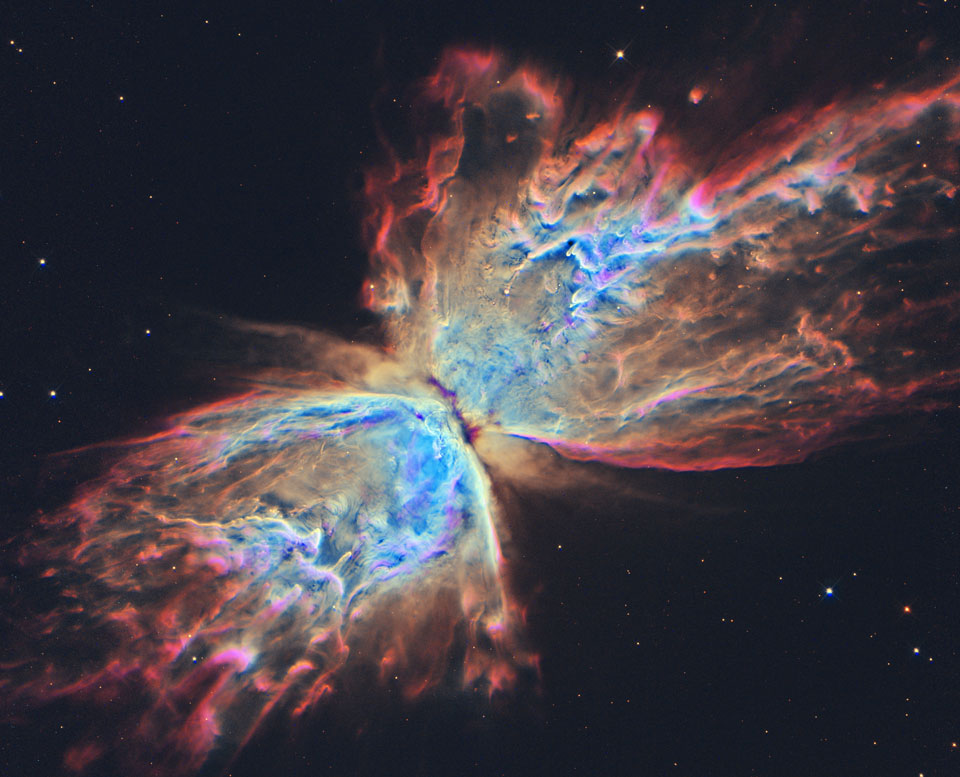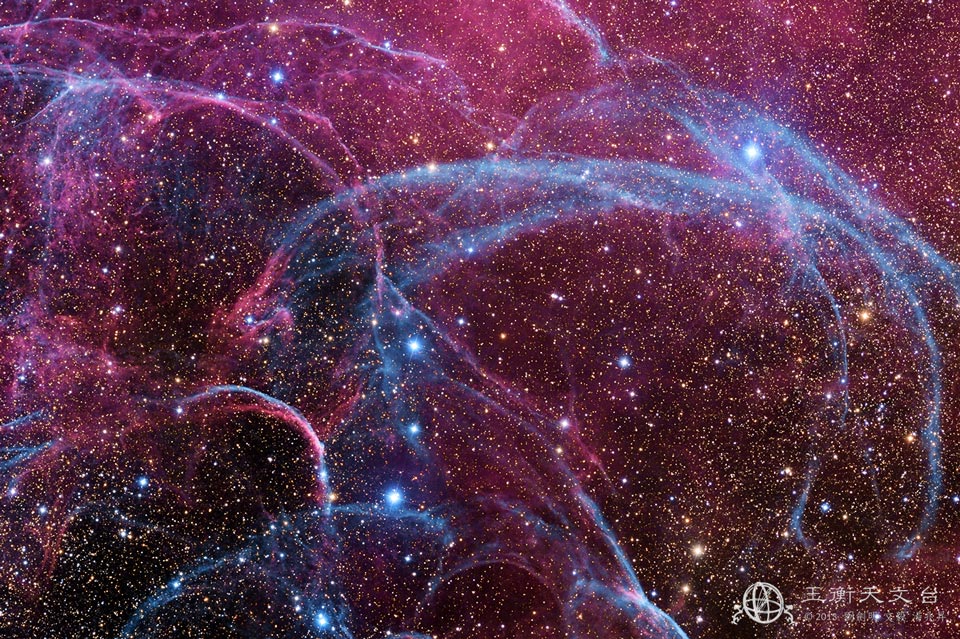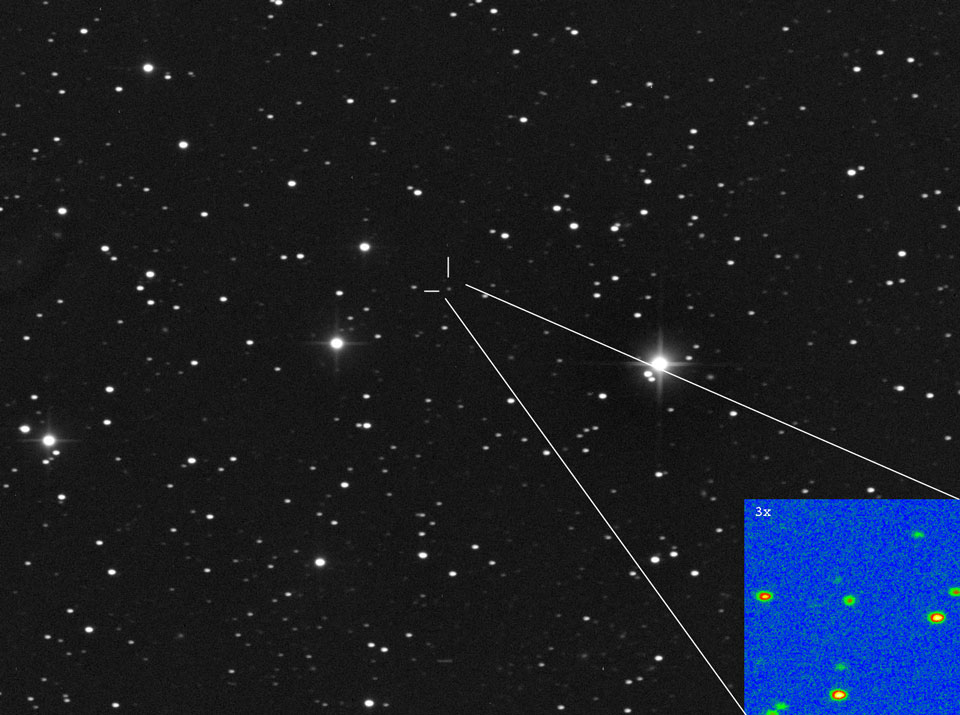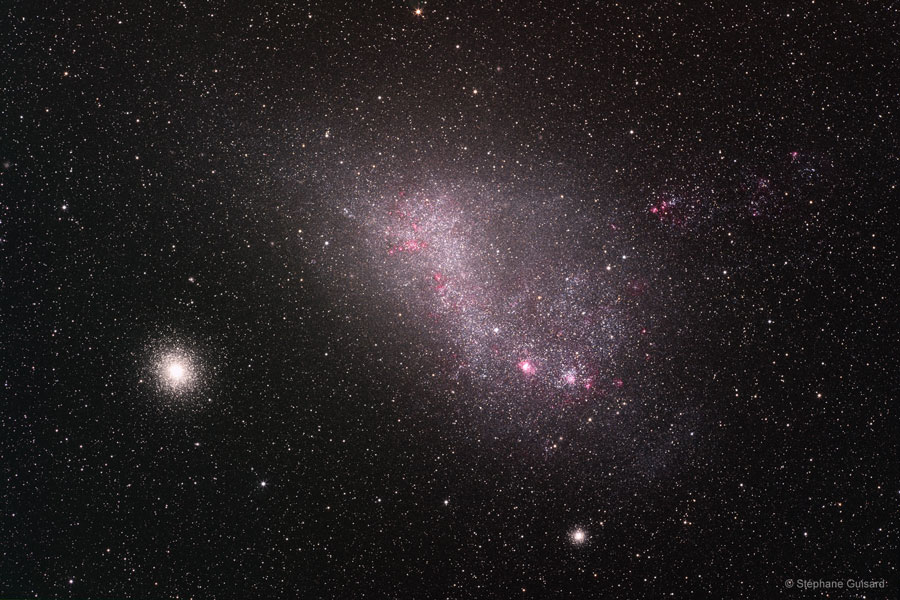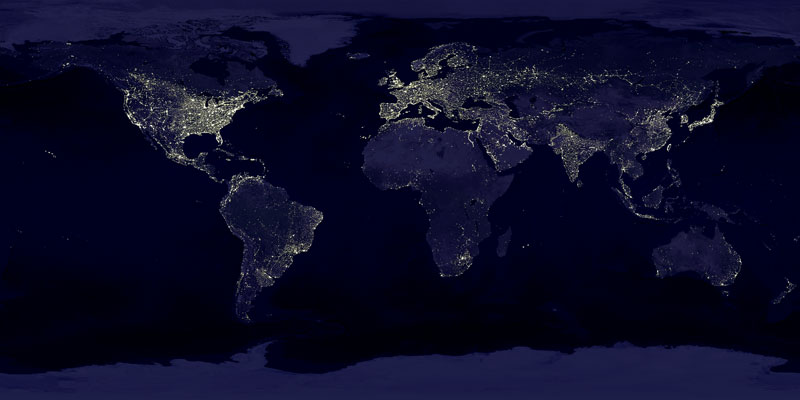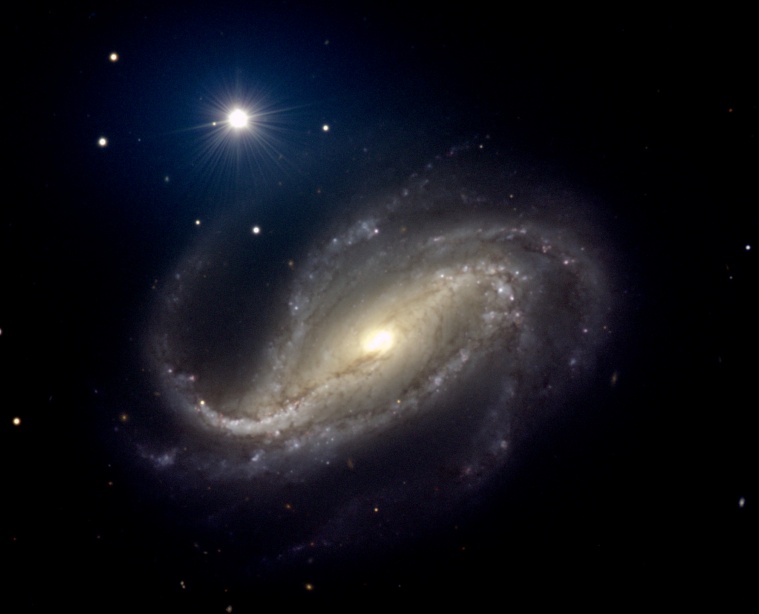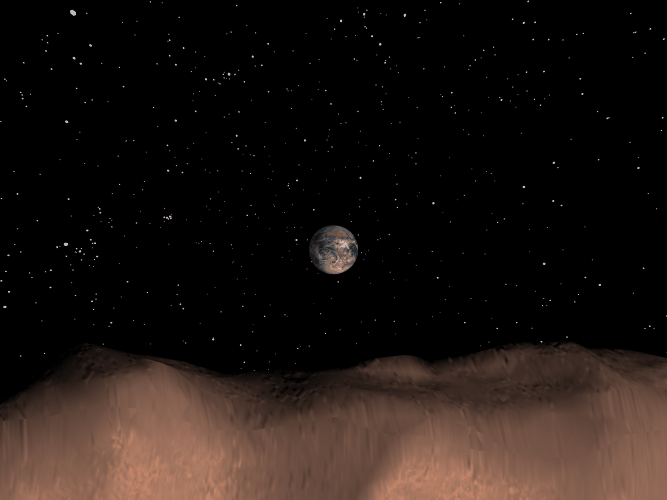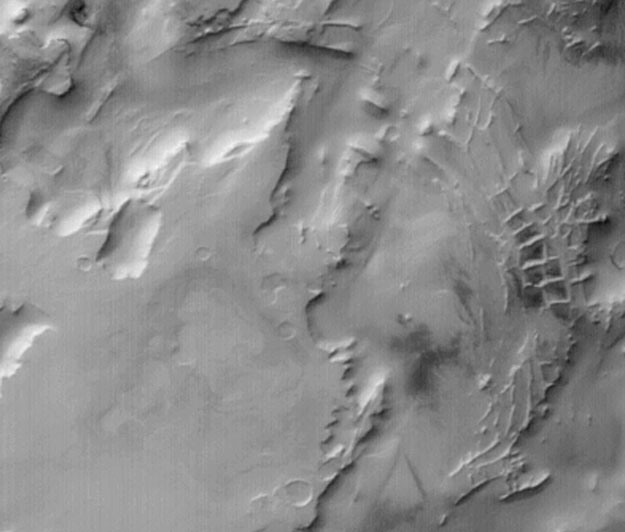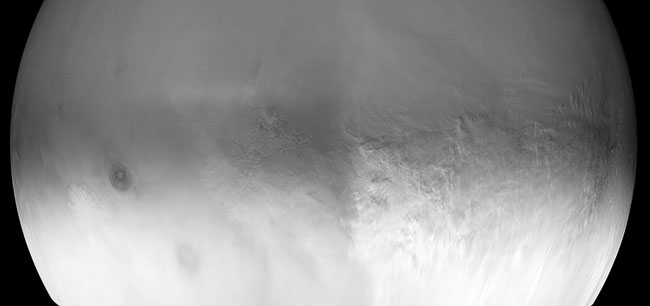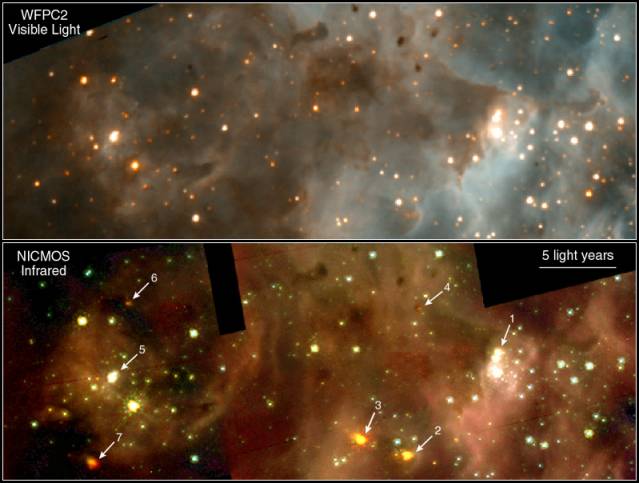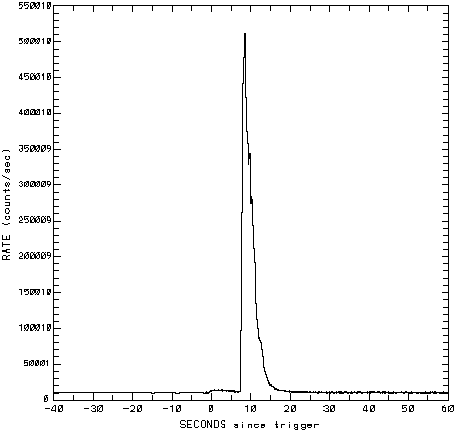[table][tr][td=left]<< Previous[/td][td=center]Index[/td][td=right]Next >>[/td][/tr][/table][/b]
2014 The bright clusters and nebulae of planet Earth's night sky are often named for flowers or insects. Though its wingspan covers over 3 light-years, NGC 6302 is no exception. With an estimated surface temperature of about 250,000 degrees C, the dying central star of this particular planetary nebula has become exceptionally hot, shining brightly in ultraviolet light but hidden from direct view by a dense torus of dust. This sharp close-up of the dying star's nebula was recorded in 2009 by the Hubble Space Telescope's Wide Field Camera 3, and is presented here in reprocessed colors. Cutting across a bright cavity of ionized gas, the dust torus surrounding the central star is near the center of this view, almost edge-on to the line-of-sight. Molecular hydrogen has been detected in the hot star's dusty cosmic shroud. NGC 6302 lies about 4,000 light-years away in the arachnologically correct constellation of the Scorpion (Scorpius).
2013 The explosion is over but the consequences continue. About eleven thousand years ago a star in the constellation of Vela could be seen to explode, creating a strange point of light briefly visible to humans living near the beginning of recorded history. The outer layers of the star crashed into the interstellar medium, driving a shock wave that is still visible today. A roughly spherical, expanding shock wave is visible in X-rays. The above image captures some of that filamentary and gigantic shock in visible light. As gas flies away from the detonated star, it decays and reacts with the interstellar medium, producing light in many different colors and energy bands. Remaining at the center of the Vela Supernova Remnant is a pulsar, a star as dense as nuclear matter that rotates completely around more than ten times in a single second.
2012 Could this dim spot brighten into one of the brightest comets ever? It's possible. Alternatively, the comet could break up when it gets closer to the Sun, or brighten much more modestly. Sky enthusiasts the world over are all abuzz, though, from the more optimistic speculations -- that the newly discovered C/2012 S1 (ISON) could develop a spectacular tail or briefly approach the brightness of the full Moon toward the end of 2013. Comet ISON currently is very faint but is just visible at magnitude 18 in the above image. The comet, discovered just over a week ago from Russia by Vitali Nevski (Belarus) and Artyom Novichonok (Russia), is currently falling toward the Sun from between the orbits of Jupiter and Saturn. In early 2013 October it will pass very near Mars and possibly be visible to rovers and orbiting spacecraft. Comet ISON appears on course to achieve sungrazer status as it passes within a solar diameter of Sun's surface in late 2013 November. Whatever survives will then pass nearest the Earth in late 2013 December. Astronomers around the world will be tracking this large dirty snowball closely to better understand its nature and how it might evolve during the next 15 months.
2011 Though the sizes are not to scale, the Sun and planets of the inner solar system are shown in this illustration, where each red dot represents an asteroid. New results from NEOWISE, the infrared asteroid hunting portion of the WISE mission, are shown on the left compared to old population projections of mid-size or larger near-Earth asteroids from surveys at visible wavelengths. And the good news is, NEOWISE observations estimate there are 40 percent fewer near-Earth asteroids that are larger than 100 meters (330 feet), than indicated by visible light searches. Based on infrared imaging, the NEOWISE results are more accurate as well. Heated by the Sun, asteroids of the same size radiate the same amount of infrared light, but can reflect very different amounts of visible sunlight depending on how shiny their surface is, or their surface albedo. That effect can bias surveys based on optical observations. NEOWISE results reduce the estimated number of mid-size near-Earth asteroids from about 35,000 to 19,500, but the majority still remain undiscovered.
2010 A mere 20 light-years away in the constellation Libra, red dwarf star Gliese 581 has received much scrutiny by astronomers in recent years. Earthbound telescopes had detected the signatures of multiple planets orbiting the cool sun, two at least close to the system's habitable zone -- the region where an Earth-like planet can have liquid water on its surface. Now a team headed by Steven Vogt (UCO Lick), and Paul Butler (DTM Carnagie Inst.) has announced the detection of another planet, this one squarely in the system's habitable zone. Based on 11 years of data, their work offers a very compelling case for the first potentially habitable planet found around a very nearby star. Shown in this artist's illustration of the inner part of the exoplanetary system, the planet is designated Gliese 581g, but Vogt's more personal name is Zarmina's World, after his wife. The best fit to the data indicates the planet has a circular 37 day orbit, an orbital radius of only 0.15 AU, and a mass 3.1 times the Earth's. Modeling includes estimates of a planet radius of 1.5, and gravity at the planet's surface of 1.1 to 1.7 in Earth units. Finding a habitable planet so close by suggests there are many others in our Milky Way galaxy.
2009
[imghover6=http://apod.nasa.gov/apod/image/0910/ca ... hst900.jpg]http://apod.nasa.gov/apod/image/0910/ca ... hst900.jpg[/imghover6]Credit: NASA, ESA, and the Hubble SM4 ERO Team
2008 A new chapter in space flight began on 1950 July with the launch of the first rocket from Cape Canaveral, Florida: the Bumper V-2. Shown above, the Bumper V-2 was an ambitious two-stage rocket program that topped a V-2 missile base with a WAC Corporal rocket. The upper stage was able to reach then-record altitudes of almost 400 kilometers, higher than even modern Space Shuttles fly today. Launched under the direction of the General Electric Company, the Bumper V-2 was used primarily for testing rocket systems and for research on the upper atmosphere. Bumper V-2 rockets carried small payloads that allowed them to measure attributes including air temperature and cosmic ray impacts. Seven years later, the Soviet Union launched Sputnik I and Sputnik II, the first satellites into Earth orbit. In response in 1958, 50 years ago today, the US created NASA.
2007 Portuguese navigator Ferdinand Magellan and his crew had plenty of time to study the southern sky during the first circumnavigation of planet Earth. As a result, two celestial wonders easily visible for southern hemisphere skygazers are known as the Clouds of Magellan. These cosmic clouds are now understood to be dwarf irregular galaxies, satellites of our larger spiral Milky Way Galaxy. The Small Magellanic Cloud pictured above actually spans 15,000 light-years or so and contains several hundred million stars. About 210,000 light-years distant in the constellation Tucana, it is the fourth closest of the Milky Way's known satellite galaxies, after the Canis Major and Sagittarius Dwarf galaxies and the Large Magellanic Cloud. This gorgeous view also includes two foreground globular star clusters NGC 362 (bottom right) and 47 Tucanae. Spectacular 47 Tucanae is a mere 13,000 light-years away and seen here to the left of the Small Magellanic Cloud.
2006 This is what the Earth looks like at night. Can you find your favorite country or city? Surprisingly, city lights make this task quite possible. Human-made lights highlight particularly developed or populated areas of the Earth's surface, including the seaboards of Europe, the eastern United States, and Japan. Many large cities are located near rivers or oceans so that they can exchange goods cheaply by boat. Particularly dark areas include the central parts of South America, Africa, Asia, and Australia. The above image is actually a composite of hundreds of pictures made by the orbiting DMSP satellites.
2005
2004 On Wednesday, September 29, the Earth came within one million miles of the asteroid Toutatis -- the closest predicted aproach of our fair planet to a sizable asteroid or comet in this century. Coming within one million miles or about 4 times the Earth-Moon distance, Earth would appear to be nearly the size of the full moon in the asteroid's sky, as suggested in this illustration. In Earth's sky, Toutatis appeared only as a faint object rapidly moving against a background of stars. Also known as Earth-crossing asteroid 4179, Toutatis is in an eccentric 4 year orbit which moves it from the asteroid belt between Mars and Jupiter to just inside Earth's orbit. When the Earth passed near it in 1992 Toutatis was imaged by radar and seen to be two irregularly shaped lumps, perhaps joined by a narrow neck. This bizarre object is up to 1.5 miles wide, 3 miles long, and is tumbling through space. Studies of Toutatis and other Earth-crossing asteroids help reveal connections between the Solar System's meteorites, main-belt asteroids and comets. These asteroids also offer tantalizing targets for robotic exploration and, over time, represent potential collision hazards for planet Earth!
2003 Jon Burnett, a teenager from South Wales, UK, was photographing some friends skateboarding last week when the sky did something very strange. By diverting his camera, he was able to document this rare sky event and capture one of the more spectacular sky images yet recorded. Roughly four minutes later, he took another picture of the dispersing trail. What is it? Experts disagree. The first guess was a sofa-sized rock that exploded as a daytime fireball, but perhaps a better hypothesis is an unusual airplane contrail reflecting the setting Sun. Bright fireballs occur over someplace on Earth nearly every day. A separate bolide, likely even more dramatic, struck India only a few days ago.
2002 What could cause rectangular ridges on Mars? As data flows in from the two spacecraft currently orbiting Mars, surface structures are seen that are not immediately understood. These structures pose puzzles that planetary geologists are eager to solve, as they might provide clues to past processes that have shaped Mars over billions of years. On the right of the above image is an unusual array of ridges first spotted in Mariner 9 data in 1972. A ridge wall runs for about 5 kilometers. Two competing progenitor theories include hardened sand dunes and once-molten rock that seeped through surface cracks and cooled. Dubbed "Inca City" for their resemblance to stone walls of an ancient Earth civilization, the new Mars Global Surveyor images now show them to be part of a larger circular pattern, indicating an origin possibly related to the impact crater. (Non-natural origin hypotheses are not invoked by conservative scientists unless clear indications exist that natural processes could not work.)
2001 A dust storm on Mars can involve nearly the entire planet. As spring descended on the southern hemisphere of the red planet this June and July, a global dust storm raged. Pictured above is the storm on July 8 as it spread up from the south, oriented on the lower right. The image was captured by the robot Mars Global Surveyor spacecraft which continues to orbit the red planet. A smaller dust storm is visible in the north to the left of the dark giant volcano Ascraeus Mons. Far-reaching dust storms also occur on planet Earth.
2000 A fantastic jumble of young blue star clusters, gigantic glowing gas clouds, and imposing dark dust lanes surrounds the central region of the active galaxy Centaurus A. This mosaic of Hubble Space Telescope images taken in blue, green, and red light has been processed to present a natural color picture of this cosmic maelstrom. Infrared images from the Hubble have also shown that hidden at the center of this activity are what seem to be disks of matter spiraling into a black hole with a billion times the mass of the Sun! Centaurus A itself is apparently the result of a collision of two galaxies and the left over debris is steadily being consumed by the black hole. Astronomers believe that such black hole central engines generate the radio, X-ray, and gamma-ray energy radiated by Centaurus A and other active galaxies. But for an active galaxy Centaurus A is close, a mere 10 million light-years away, and is a relatively convenient laboratory for exploring these powerful sources of energy.
1999
1998 Happy Birthday, NASA! The National Aeronautics and Space Administration officially began operations on October 1, 1958, absorbing its forerunner organization the National Advisory Committee for Aeronautics, NACA. Its landmark achievements in human spaceflight include the Mercury and Gemini Projects culminating in the Apollo Project moon landings in the 1960s and early 1970s, Apollo-Soyuz and Skylab in the 1970s, and the Space Shuttle program of the 1980s and 1990s. (Pictured is the June 1998 launch of the Space Shuttle Discovery.) NASA's science programs have produced the robotic exploration of our Solar System, views of the Universe across the electromagnetic spectrum, and valuable meteorological and remote-sensing Earth observations. At birth, NASA's priorities were largely driven by the pressures and competitions of the Cold War. But looking back over 40 years, the sum of its accomplishments have produced needed new technologies and a vital new perspective on Planet Earth and the Cosmos.
1997 "Do not look at stars as bright spots only - try to take in the vastness of the universe." Today is the 150th anniversary of the day Maria Mitchell swept the sky with her telescope and discovered the comet of 1847 (comet Mitchell 1847VI). Honored and recognized internationally for her discovery, Mitchell, who lived from 1818 to 1889, became one of the most famous American scientists of her day. Vassar College appointed Mitchell the first woman Professor of Astronomy and she remained the only woman ever elected to the American Academy of Arts and Sciences until 1943. Mitchell mentored a generation of scientists, and is fondly remembered for her ability to motivate. "We especially need imagination in science," Maria Mitchell said. "Question everything."
1996 Something big exploded but astronomers have no idea what. On September 24th, the Burst and Transient Source Experiment (BATSE) onboard the orbiting Compton Gamma Ray Observatory recorded the most intense gamma ray burst in its five year history. During its mission, BATSE has recorded many gamma ray bursts - about one per day, but none were this powerful. Since their discovery over 25 years ago, the origin and even distance to gamma ray bursts remains hotly debated. Bursts are surely mysterious phenomena: they flash into existence suddenly dominating the entire gamma-ray sky, then typically fade in a few seconds never to be seen again. It is possible that this intense wave of gamma radiation caused other satellites to glitch and may even have been the cause of unusual noise in the Earth's atmosphere. If you know of such an anomaly, please report it.
1995 The pictured core of the galaxy NGC 253 shows an exceptionally high rate of star formation. In the center are some of the densest knots of stars ever found, surrounded by glowing gas and dust lanes. Galaxies where such high star formation rates are seen are called "starburst" galaxies. The unusual color is a combination of the light emitted from the young, hot, blue stars and their associated emission and reflection nebulae.
| << Previous | Index | Next >> |
